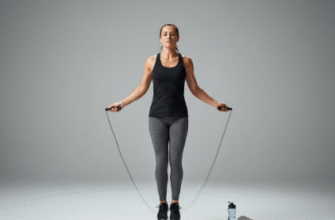Stepping onto a balance disc for the first time feels… wobbly. That slight instability, however, is precisely where the magic happens for your fitness routine. These unassuming, often brightly colored inflatable cushions are far more than just a gimmick; they are potent tools for enhancing various aspects of physical conditioning. Incorporating balance disc training, also known as stability training, introduces an element of controlled instability that forces your body to work harder in ways traditional exercises on a flat surface simply cannot replicate.
The core idea is simple: when you perform an exercise on an unstable surface like a balance disc, your body constantly needs to make micro-adjustments to maintain equilibrium. This continuous effort recruits muscles that might otherwise remain dormant during standard movements. Think of it like walking on uneven ground versus a smooth pavement – your ankles, legs, and core work much harder on the tricky terrain. Balance discs bring that beneficial challenge into your controlled workout environment.
Unlocking Core Power
One of the most significant advantages of using balance discs is the profound impact on core strength and stability. Your core isn’t just your abs; it includes the complex network of muscles in your abdomen, lower back, hips, and pelvis. These muscles act as the central stabilizing unit for your entire body. When you stand, sit, or perform exercises like squats or lunges on a balance disc, your core muscles must fire constantly to keep you upright and balanced. This sustained engagement leads to increased strength, endurance, and coordination within the core musculature. A stronger core translates directly to better posture, reduced risk of lower back discomfort, and improved performance in virtually any physical activity, from carrying groceries to playing sports.
Beyond the Abs: Deep Stabilizer Engagement
Traditional core exercises often target the more superficial muscles, like the rectus abdominis (the “six-pack” muscles). Balance discs excel at activating the deeper stabilizing muscles, such as the transverse abdominis and multifidus. These muscles play a crucial role in spinal stability and control. By challenging your balance, the disc forces these deep muscles to engage reflexively, leading to a more functionally strong and resilient core structure. You might not see these muscles in the mirror, but their strength is fundamental to overall movement quality and injury prevention.
Sharpening Your Balance and Proprioception
Balance isn’t just about not falling over; it’s a complex skill involving coordination between your brain, inner ear, eyes, and specialized sensory receptors in your muscles and joints called proprioceptors. Proprioception is essentially your body’s awareness of its position in space. Training on a balance disc directly challenges and enhances this system.
The unstable surface provides constant feedback, forcing your proprioceptors to work overtime, sending rapid signals to your brain about joint position and muscle tension. Your brain then sends commands back to your muscles to make the necessary adjustments. Over time, this process becomes more efficient. You’ll likely notice improvements not just during your workouts but also in everyday life – navigating crowded spaces, reacting to unexpected trips, or participating in activities requiring agility becomes easier and safer. This enhanced proprioceptive ability is invaluable for athletes and the general population alike.
Consistent training on unstable surfaces like balance discs demonstrably improves proprioceptive feedback loops. This heightened body awareness allows for quicker muscular responses to changes in balance. Consequently, this contributes significantly to enhanced stability and a reduced likelihood of falls or stumbles during dynamic activities.
Supporting Joint Health and Stability
Balance discs aren’t just for the core; they provide significant benefits for joint stabilization, particularly around the ankles, knees, and hips. When you stand or perform lower body exercises on the disc, the small muscles surrounding these joints must work diligently to maintain alignment and control movement.
Ankle and Knee Resilience
For instance, simply standing on one leg on a balance disc intensely challenges the muscles and ligaments around the ankle. This strengthens them, potentially improving stability and reducing the risk of sprains. Similarly, performing gentle knee bends or squats on the disc encourages co-contraction of the muscles around the knee joint, promoting stability and control. This low-impact strengthening can be particularly beneficial for individuals seeking to improve joint function without excessive strain.
Hip Stabilizer Activation
The hip joint, a crucial link in the kinetic chain, also benefits immensely. Exercises like bridges or single-leg stands on the disc activate the often-underworked hip abductor and external rotator muscles. Strengthening these stabilizers improves pelvic control, gait mechanics, and can contribute to alleviating stress on the lower back and knees.
Versatility in Application
Perhaps one of the most appealing aspects of balance discs is their sheer versatility. They can be seamlessly integrated into a wide array of exercises, modifying familiar movements to add a new dimension of challenge.
- Standing Exercises: Squats, lunges, single-leg deadlifts, and even simple standing balance work become significantly more demanding.
- Seated Exercises: Placing a disc on a chair promotes ‘active sitting’. It forces subtle core engagement to maintain posture, combating the slumping often associated with prolonged sitting.
- Floor Exercises: Incorporate discs into push-ups (one hand or foot on the disc), planks (forearms or feet on discs), or bridging exercises to intensify core and stabilizer activation.
This adaptability means they can be used by individuals across various fitness levels, from beginners looking to improve basic stability to advanced athletes seeking an extra edge in their performance training. You can adjust the difficulty simply by altering the inflation level of the disc – less air generally means more instability.
Accessibility and Injury Considerations
Compared to larger, more expensive stability equipment, balance discs are relatively affordable and portable. They require minimal space for use and storage, making them ideal for home workouts or for trainers to carry with them. Their low-impact nature also makes them suitable for certain phases of rehabilitation, helping to gently reintroduce load and challenge balance after injury, always under the guidance of a qualified professional.
While beneficial for general fitness and strengthening stabilizing muscles, always consult with a healthcare provider or physical therapist before using balance discs for injury rehabilitation. Start slowly, focusing on control rather than range of motion, especially if you are new to stability training. Proper form is crucial to avoid strain.
While not a magic bullet, incorporating balance disc training offers a practical and effective way to boost core strength, enhance balance and proprioception, improve joint stability, and add variety to your fitness regimen. By challenging your body’s equilibrium, you unlock a deeper level of muscular engagement and functional fitness that translates far beyond the gym. Whether you’re aiming to improve athletic performance, increase everyday functional strength, or simply make your workouts more engaging, the humble balance disc provides a powerful platform for progress.








